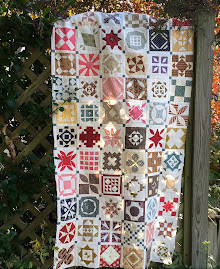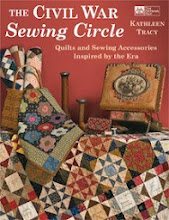I recently received several e-mails from quilters asking me how I choose my fabrics for my scrappy quilts. This question comes up frequently when I lecture as well, leading me to think that not everyone finds it as easy as some.
Unlike quilters from the past, quilters today are really lucky to have such a wonderful array of fabrics to choose from when making their quilts. But it can really get overwhelming sometimes with the wide variety available and it's fairly common to lack confidence in picking out fabrics for a scrap quilt, particularly if some of you are new to quilting. So here's how I get my look.
Quilts from the 19th century were anything but drab brown, and although brown WAS commonly used in quilts made during this period, quilts then were also pretty colorful. If you love making scrappy quilts with an antique look but get confused or overwhelmed by the task of choosing good fabrics, here are a couple of tips that I found work for me.
* Begin collecting colors and prints in muted shades that you like a little at a time. But don't just buy the same colors you like over and over. If you're intent on making scrap quilts, get a good varied collection going that you will use for years.
* I organize my fabrics by color in drawers or bins. Make sure you have a good selection of reds, blues, indigos (dark blues), greens, pinks, light shirting prints, browns, tans and golds. Yep, that means a separate place for each color.
* Choose a variety of different geometrics and florals for each color.
* Make sure you have quite a few shirting prints or tans for block backgrounds.
* Throw in a few black prints and purple too and you can do almost anything!
I mostly use smaller prints for my small quilts--geometrics, dots and tiny florals, and an occasional larger print for interest. Make sure you have a few checks, plaids and stripes for interest too. Mix the larger prints with the smaller prints.
If you're going for an antiquey look, if there's a fabric you already have and like but it's too bright when placed next to another print, soak a small piece of it in a cup or bowl of tea to tone down the brightness.Try several tea bags, then soak the fabric for a few minutes to see if it darkened. (I make 2 cups of tea when I sew--one for me and one for the quilt, LOL.) This works for me sometimes. I really don't like to tea dye the whole quilt to give it that brown look. I hardly ever use white unless I am making a thirties quilt. In the doll quilt below, I soaked some of the bright pink scraps in tea to tone them down a bit. They still pop, but the contrast is not as great because the pinks have more of a soft "tinge."
Add some contrast to your quilt by using different, darker hues of the same color instead of large prints or bright fabrics. Decide if you want a LOT of contrast or a little in your quilt. Choose prints in colors that pop out from the surrounding pieces if you want a lot of contrast. Here's a good example in the quilt below. Instead of placing the red piece next to the black or blue ones and only using dark shades for the star points, I broke it up with medium prints in tan, green and gold for more contrast. Making the red pop out gives it interest I think.
I just recently finished making a small quilt that has mostly darker, muted colors--indigos, tan and black mixed with shirtings--and in the center I threw in a few pink pieces. I love the blues and grays in this antique quilt top someone showed me because it uses the same theory and would be pretty dull without the red or pink. Another thing to try: I like to repeat one of my favorite colors throughout the quilt to pull the scrappiness together. Not difficult to guess what color that is . . . .
You also need to consider value when you're making a scrappy quilt, which is the relative lightness or darkness of a fabric. Value is what makes different colors look so pleasing when placed next to each other. Strive for a pattern of light and dark values throughout the quilt to create a vintage-looking softness.
You can create contrast by choosing light and dark hues of the same colors as well. There are clumps of blue in this scrappy quilt but I think it works because they're different shades and different prints of the same color. Try making it with YOUR favorite color. Or pick two and see what happens.
There's a free pattern on my website for this little quilt.
The great thing about making small scrappy quilts is that you can experiment with different colors without spending a lot of time, energy or money. Be creative, experiment and it will all come together eventually.
NEXT TIME: On the Borders . . .





































































